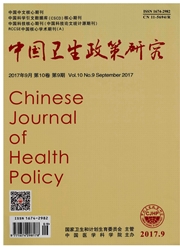

 中文摘要:
中文摘要:
目的:分析农村基层医疗卫生机构视力检查服务的可及性对居民视力检查服务利用的影响。方法:利用医疗卫生机构和农户调查数据,采用描述统计和多元回归分析。结果:样本中33.2%的居民自报告视力不良,22.1%的居民曾做过视力检查,86%样本乡镇的卫生院和44%样本村的村卫生室可以提供视力检查服务;回归结果显示,乡镇卫生院提供视力检查服务将显著增加居民进行视力检查的可能性,但村卫生室是否提供视力检查服务对居民视力检查的利用没有显著影响。结论:农村居民对视力检查服务需求很大,但是利用率低。基层医疗卫生机构服务供给不足可能是导致农村居民服务利用率低的重要因素。建议国家继续推进基本公共卫生服务,加强基层医疗卫生服务机构开展基本视力检查的能力,促进农村居民对视力检查服务的利用,改善农村居民视力健康水平。
 英文摘要:
英文摘要:
Objective: To identify the vision care access in rural primary health institutions and the utilization of vision inspections among rural residents. Methods: Survey data was collected from primary health institutions (town- ship health centers and village clinics) and households. The descriptive statistics and multivariate regression analysis were applied to analyze data. Results: The household survey data shows that 33.2% of rural residents self-reported having poor vision, and 22.1% of rural residents stated that they had ever used vision care ( vision screening or vison examinations). The health facilities survey data shows that 84% of township health centers and 44% of village clinics can provide vision care. The multivariate analysis shows that the vision care access in township health centers is sig- nificantly correlated with the probability of residents' utilization of vision care, but there is no significant correlation between the provision of vision care in village clinics and its utilization. Conclusions : The vision care access is low in rural China though there is a huge demand therefore. Inadequate supply of primary vision care services in primary health institutions may result in low utilization among rural residents. It is suggested that the government further pro- mote the National Public Health Service Program and strengthen the capacity of primary health facilities to provide primary vision care. To do so, an increase in the utilization of vision care among rural residents can be expected, which would thereby reduce potential losses caused by further vision impairment.
 同期刊论文项目
同期刊论文项目
 同项目期刊论文
同项目期刊论文
 Do You Get What You Pay For with School-based Health Programs? Evidence from a Child Nutrition Exper
Do You Get What You Pay For with School-based Health Programs? Evidence from a Child Nutrition Exper The Limits of Health and Nutrition Education: Evidence from Three Randomized-Controlled Trials in Ru
The Limits of Health and Nutrition Education: Evidence from Three Randomized-Controlled Trials in Ru Impact of a Senior High School Tuition Relief Program on Poor Junior High School Students in Rural C
Impact of a Senior High School Tuition Relief Program on Poor Junior High School Students in Rural C Giving kids a head start: The impact and mechanisms of early commitment of financial aid on poor stu
Giving kids a head start: The impact and mechanisms of early commitment of financial aid on poor stu Improving the Health and Education of Elementary Schoolchildren in Rural China: Iron Supplementation
Improving the Health and Education of Elementary Schoolchildren in Rural China: Iron Supplementation The impact of vouchers on preschool attendance and elementary school readiness: A randomized control
The impact of vouchers on preschool attendance and elementary school readiness: A randomized control 期刊信息
期刊信息
